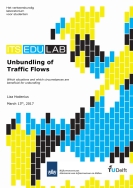The study has been conducted in order to develop a method to determine in which situations unbundling (i.e. the separation of traffic flows), can be used to solve bottlenecks on motorways. Although unbundling has already been applied in the Netherlands, success of this method has been varying. It remains unclear in which situations this measure can lead to an effective and robust solution. Two main goals were set for this study. On the one hand, the situations in which unbundling can be considered an option and on the other hand, circumstances under which unbundling can be deemed beneficial. This led to the following research question: ‘To what extend can unbundling of traffic flows be considered as a potential solution in solving bottlenecks on motorways and are there (any) circumstances in which unbundling can be deemed societally beneficial?’
Unbundling is defined as separation of through and local traffic on motorways by a physical separated main carriageway and parallel road. Based on existing literature three situations can be determined in which unbundling can be applied: policy reasons, safety reasons and/or because of capacity problems. This study focussed on the capacity issues. A decision tree was built of these situations in which unbundling can be applied. In order to find out if there are circumstances in which unbundling can be deemed societally beneficial, simulations are used. One standard situation was chosen to test under different circumstances. The simulation program that was chosen to execute this with was MARPLE. The standard situation, base case, was considered a three lane carriageway with a length of 9 km and a maximum speed of 120 km/h. Two connections are included, which means two on-ramps and two off-ramps. The alternatives include an extended alternative (four lanes on the main carriageway) and four unbundled alternatives.
Unbundling of traffic flows can be considered a potential solution in solving bottlenecks on motorways, but to a limited extend. The unbundling measure can only be deemed societally beneficial for one alternative: 50% through traffic and 50% local traffic and the initial traffic demand. This alternative consists of a main carriageway with two lanes and the parallel road exits of two lanes as well (the unbundled 2-2 alternative). This result that the unbundling measure is only societally beneficial in one situation can partly be explained by the high investment & maintenance costs for unbundled alternatives in comparison to building an extra lane. From the simulations it coulds also be concluded that the extended and the unbundled 2-2 alternatives perform the best under increased traffic demand circumstances and therefore are the most robust alternatives. There are three main limitations considered in this study. First of all, besides the circumstances all data was static. Secondly, the simulations were strongly simplified. Finally, the effects of safety and noise pollution are not properly take into account in the CBAs. Since safety effects can have a much bigger impact than travel time effects and unbundled situations are considered safer than not-unbundled situations, the CBAs are probably underestimated for unbundled situations. Besides, whether the CBA is positive or not, the decision for implementing one of the alternatives or changing the road infrastructure, is still a decision made by the government.
